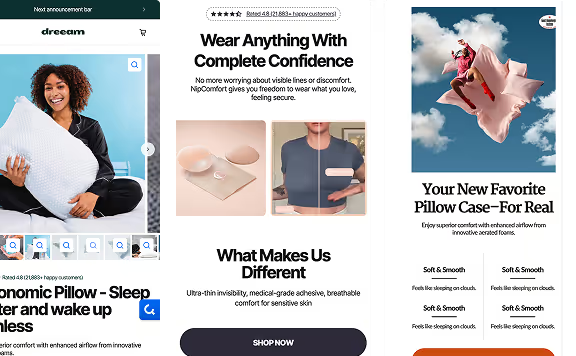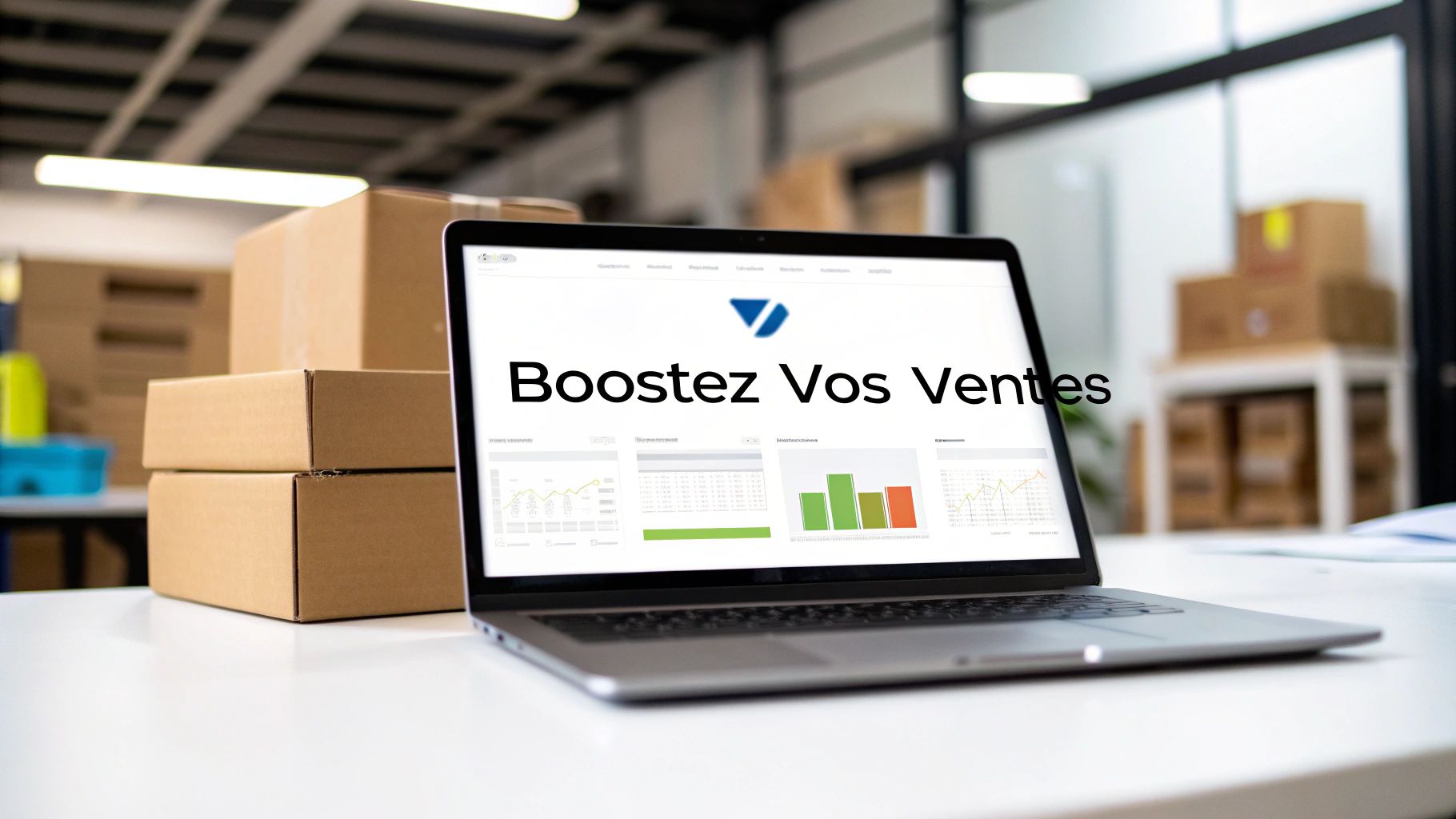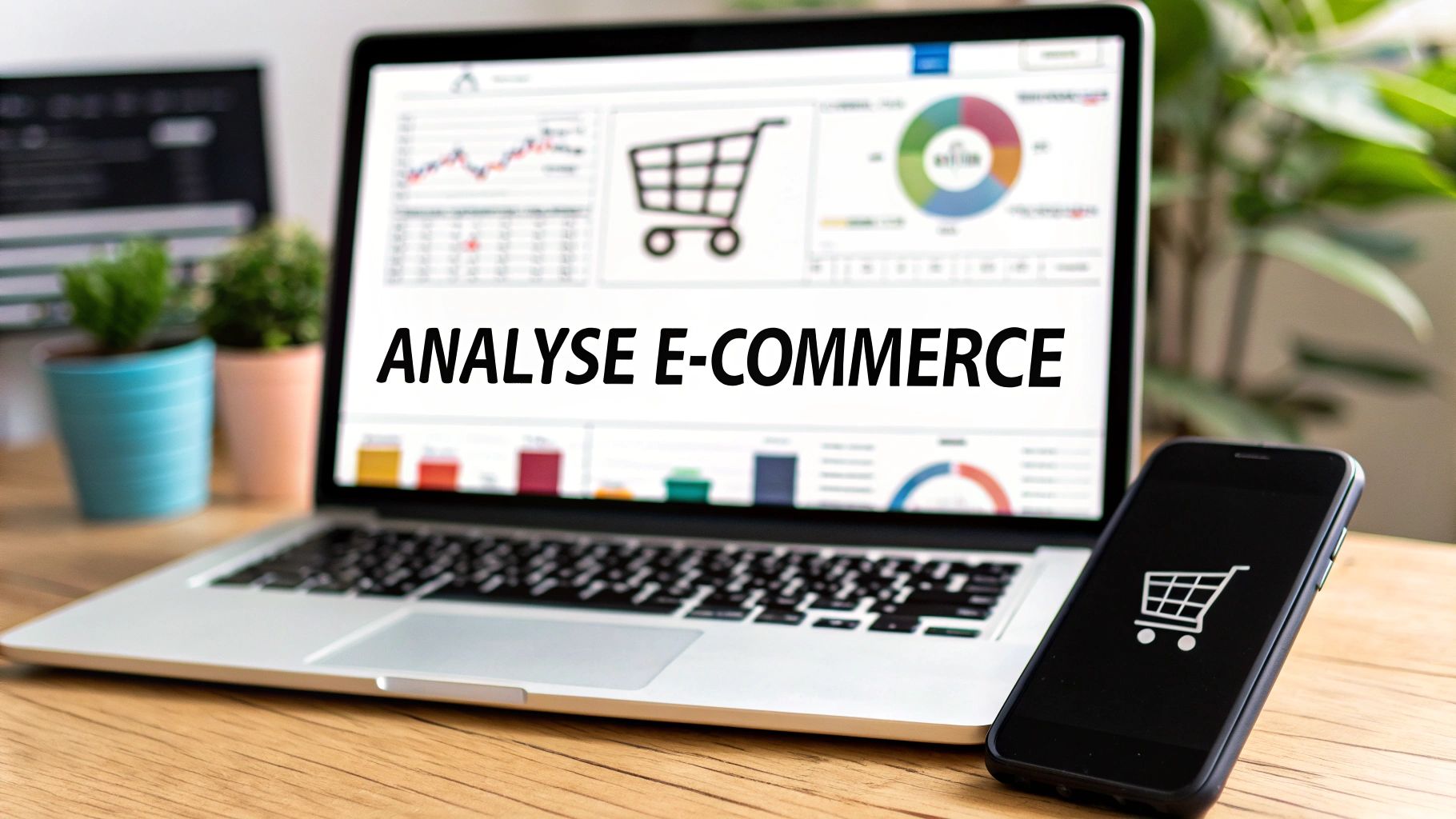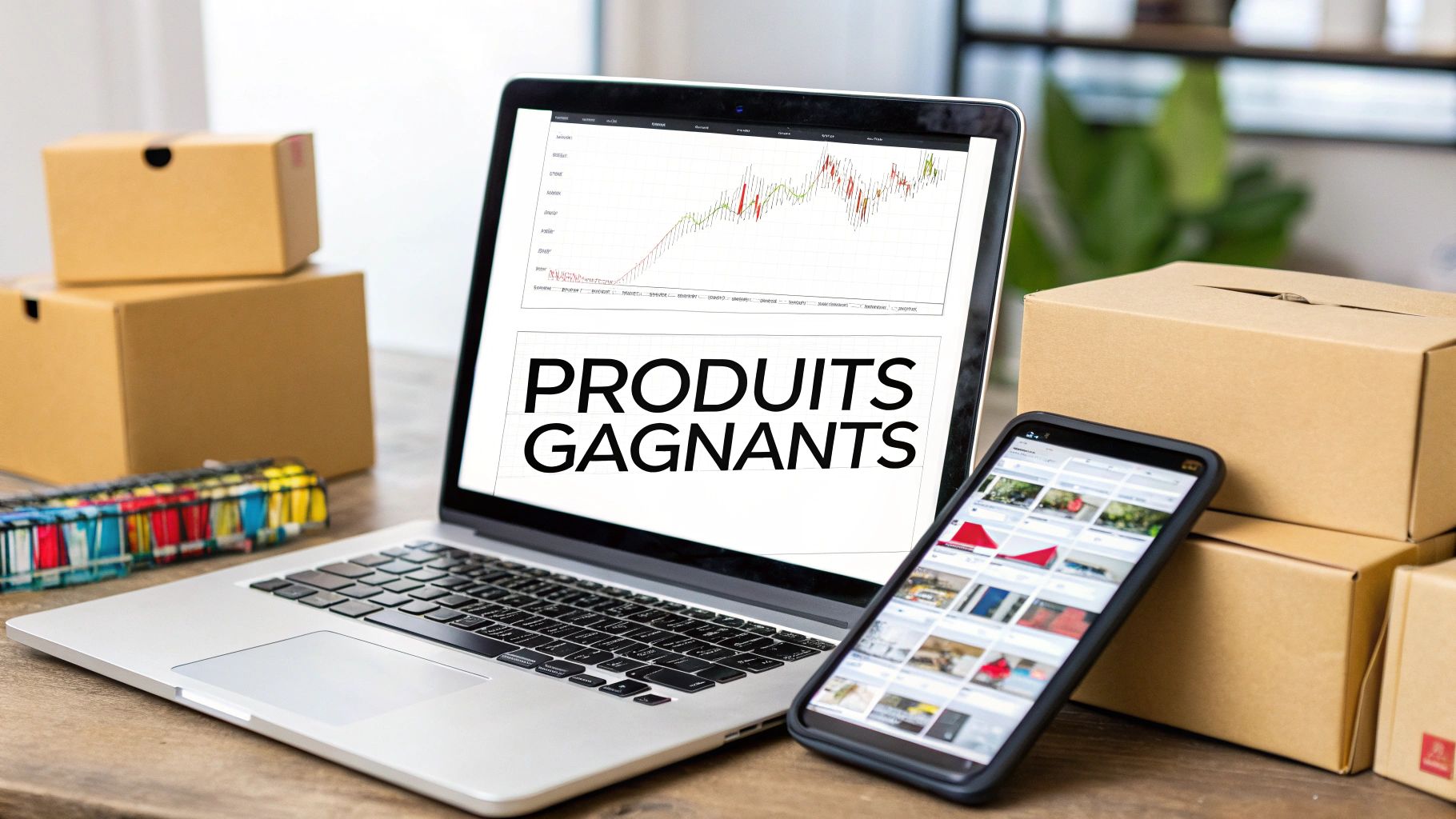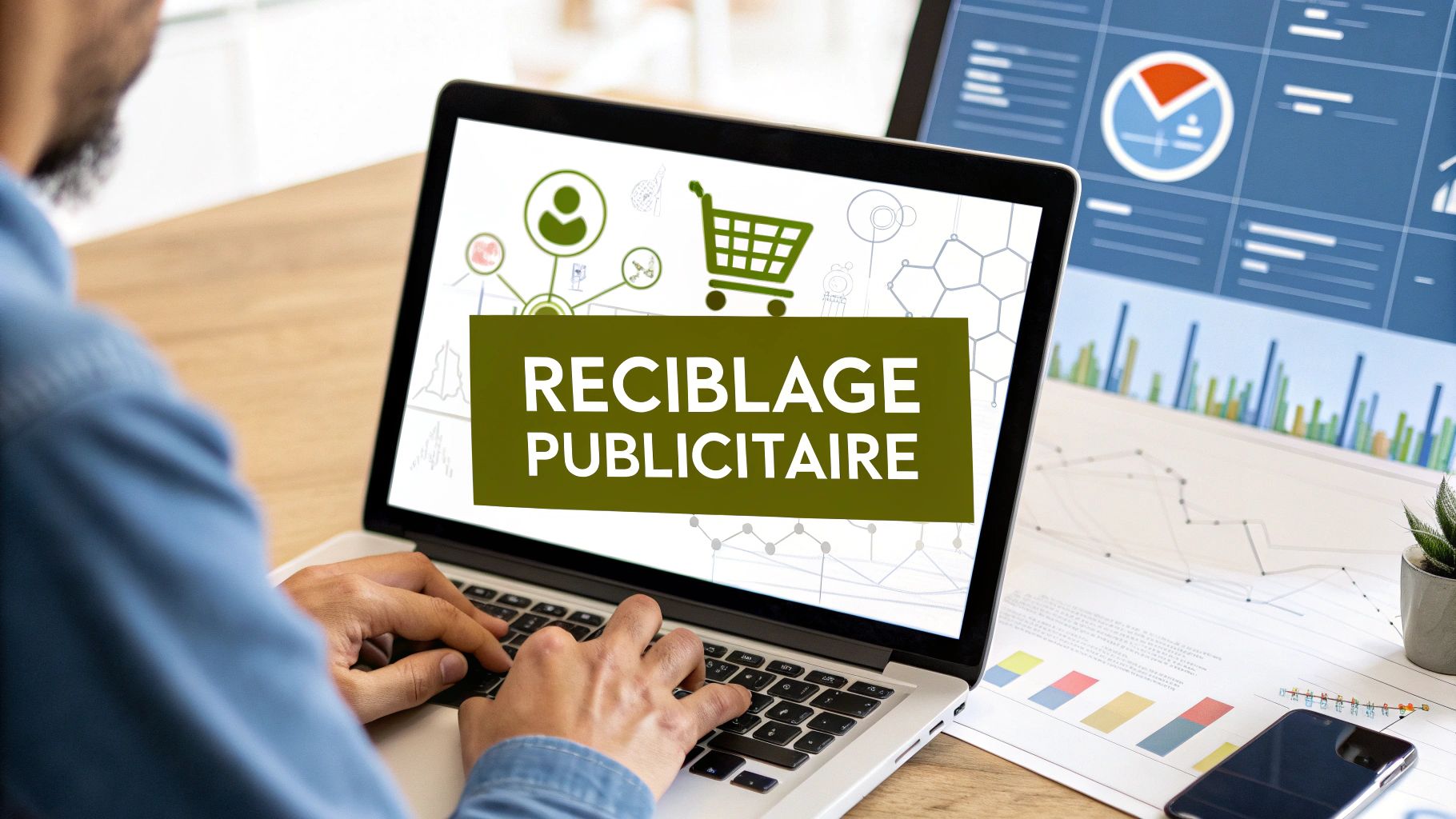Marketing & Acquisition for e-commerce, a complete guide to generate traffic and sales!
In short: The 5 essential points to remember
No time to read it all? Here are the essentials of this guide in 5 key points:
- Acquisition without loyalty = loss of money : Your goal is not just to make a sale, but to create repeat customers. A customer who orders 3 times is worth infinitely more than a one-shot buyer. Profitability is achieved over time, not on the first order.
- The 3 essential levers to start : SEO for free and sustainable traffic, paid advertising (Meta/Google Ads) for immediate results, and email marketing for an ROI of €36 for €1 invested. Master these 3 channels before dispersing.
- Measure or die : Follow your CAC (Customer Acquisition Cost), your ROAS (Return On Ad Spend) and your LTV (Customer Lifetime Value) religiously. If your CAC is greater than 30% of your LTV, you are losing money. If your ROAS is less than 2.5, review your strategy.
- Adapt your strategy to your stadium : Starting with less than €1000? Focus on SEO and organic social networks. Between €1000 and €5000? Get started with paid advertising and email. More than 5000€? Diversify and focus on retention.
- 2025 = the year of short video and first-party data : TikTok Shop is exploding, Reels are converting 2.5x better than images, and with the end of third-party cookies, your email list is becoming your most valuable asset. Adapt or stay invisible.
Try copyfy for free
You have launched your online store, your catalog is ready, your site is perfect... but lo and behold: visitors are not jostling at the gate. Even worse, those who arrive do not order. Frustrating, no?
The real challenge of e-commerce is not creating a store. It's about attracting the right customers, at the right time, with the right message. And that's exactly what you're going to learn in this guide.
We will give you a clear and actionable roadmap to master the acquisition levers that will really boost your sales. No theoretical talk, just concrete stuff.
Try copyfy for free
Understanding the “Marketing & Acquisition” logic in e-commerce
Before jumping headlong into Facebook ads or Instagram posts, take 2 minutes to understand how e-commerce marketing really works.
The difference between marketing, acquisition, and retention
The acquisition, that's all you do to attract new visitors and turn them into customers. This is the phase where you spend money to promote your store and generate sales.
Retention, it's the art of bringing back your existing customers. And that's where real profitability comes in: retaining a customer costs 5 to 7 times less than acquiring a new one.
The marketing, on the other hand, encompasses everything: from reputation to loyalty, including brand image and customer experience.
The 3 key stages of the customer journey
Your customer is not going to magically buy from you. It goes through 3 phases:
- Awareness : he discovers your existence via an ad, a post, a Google search
- Consideration (Conversion) : he compares, hesitates, reads the reviews, adds to the basket
- Action & Loyalty : he buys, then comes back to order again
Each step requires a different strategy. You don't talk the same way to someone who doesn't know you and to a customer who has already ordered from you 3 times.
Why acquisition without loyalty is a costly trap
Here is a classic mistake: spend your entire advertising budget to acquire new customers... without ever bringing them back. Result? You're losing money.
The golden rule : your goal is not just to make a sale, but to create a recurring customer. A customer who orders 3 times a year is worth infinitely more than a one-shot buyer.
That's why email marketing, loyalty programs, and customer service are as important as your ads.
Try copyfy for free
The essential acquisition levers in 2025
Now that we've laid the foundations, let's get down to business: the channels that will bring you traffic and sales.
SEO & Content Marketing: the basis for sustainable traffic
Natural referencing (SEO), it is the most profitable channel in the long run. Why? Because once you are well positioned on Google, you receive free and qualified traffic, month after month.
How to do it?
- Optimize your product sheets with the right keywords
- Create a blog to answer questions from your customers (like this article!)
- Work on your title tags, descriptions and site structure
Concrete examples:
The biggest e-commerce stores (like the ones you see selling on Shopify) all have an active blog and ultra-optimized product sheets. It is no coincidence.
Channel Benefits & Delays | RoiseoFree, sustainable, qualified traffic 3 to 6 months Excellent (long term)SEA (Google Ads)Immediate results, very targeted Instantaneous Good (short term)
Try copyfy for free
Paid advertising (SEA, Meta Ads, TikTok Ads)
If you want quick results, paid advertising is a must. It is it that will allow you to quickly test a product and scale your sales.
The platforms to be preferred:
- Facebook & Instagram Ads : perfect for reaching a large audience with precise behavioral targeting
- Google Shopping : ideal for capturing the intention to buy (people who are actively looking for your product)
- TikTok Ads : explosive for viral products and young audiences, but beware, the learning curve is steep
The formats that are performing in 2025:
- Reels and short videos (15-30 seconds)
- Carousels with before and after or customer testimonials
- Dynamic retargeting campaigns (you relaunch those who visited your site)
The expert advice : starts with Facebook Ads, it is the most accessible and the most documented platform. Once you've mastered, branch out to Google and TikTok.
Email Marketing & Automation: the king ROI
Email marketing is the most profitable e-commerce channel. The numbers speak for themselves: for €1 invested, you can get back up to €36.
Why does it work so well?
- You reach your prospects and customers directly
- You can finely segment your messages
- You automate everything (welcome, abandoned cart, post-purchase, reminder...)
The essential automated sequences:
- Welcome email : after registering for your newsletter
- Relaunch abandoned cart : 1 hour, 24 hours and 48 hours after the abandonment (this is where you recover 10 to 30% of lost sales)
- Post-purchase : review request, cross-sell, promo code for the next order
- Reactivation : for customers who have been inactive for 60-90 days
Recommended tools : Klaviyo, Brevo, Mailchimp.
With Copyfy, you can even automatically generate your acquisition and follow-up emails in a few seconds. No need to spend hours writing.
Influencer marketing & UGC: social proof in action
People no longer buy on promises, they buy on evidence. And nothing is more powerful than a genuine recommendation.
Influencer marketing, it's getting content creators who are followed by your target audience talking about your product. But be careful: we are not necessarily talking about mega-influencers with 500k subscribers.
Micro-influencers (5k to 50k subscribers) are often more profitable:
- Higher engagement
- Accessible prices (free product or a few hundred euros)
- Highly qualified audience
UGC content (User Generated Content), these are the videos and photos created by your customers or creators, that you reuse in your ads. It's authentic, it converts better, and it's cheaper than a studio production.
Example: a cosmetics brand that has 10 micro-influencers test its products, gets 50 videos, and uses them in its Facebook ads. The result: creatives who perform 2 to 3 times better than classic ads.
Affiliation & Partnerships: from acquisition to performance
Membership is simple: you only pay when you make a sale. Zero risk, guaranteed ROI.
How does it work?
You offer content creators, bloggers or specialized sites to promote your products in exchange for a commission on each sale (generally between 5% and 20%).
The niches where it works best:
- Fashion & accessories
- Beauty & well-being
- High-tech & gadgets
- Training & digital tools
CanalInitial costRiskROI AffiliateNone (commission only) Very Low/ExcellentInfluenceMedium (products offered + remuneration) MediumGood to excellentPublicityHigh (advertising budget required) HighVariable according to skills
Try copyfy for free
How to build your acquisition strategy step by step
Now that you know the levers, let's see how to orchestrate them to create a real sales machine.
Step 1: Diagnose your current traffic and conversions
Before you spend a cent on ads, you need to know where you stand. Ask yourself these questions:
- How many visitors do you get per month?
- Where do they come from (Google, social networks, direct...)?
- What is your current conversion rate?
- What are your most visited pages and which convert the best?
The essential tools:
- Google Analytics 4 (GA4) : to analyze your traffic
- Google Search Console : to see what keywords you are appearing on
- Hotjar : to understand the behavior of your visitors (heatmaps, session recordings)
Step 2: Set clear goals and KPIs
You can't improve what you don't measure. Here are the indicators that you should definitely follow:
KPI Definition Objective Benchmark CAC (Customer Acquisition Cost)How much do you spend to acquire 1 customer< 30% of the LTVLTV (Lifetime Value)Total value of a customer over its lifetime 3x the minimum CACROAS (Return On Ad Spend)How much do you get back for €1 spent on advertising > 2.5 to be profitableConversion rate% of visitors who buy 1.5% to 3% depending on sectorAverage basketAverage order amountTo be maximized via cross-sell
Concrete example:
If your average basket is €60, your CAC is €25 and your customers order an average of 2 times, your LTV is €120. Your business is profitable.
Step 3: Choose the right channels according to your budget and stadium
Not all channels are the same depending on your level of experience and budget.
E-merchant stadiumRecommended budgetPriority channelMain objectiveBeginner< 1000€SEO + Organic Social NetworksCreate notoriety, test the marketIntermediate1000€ — 5000€Ads (Meta/Google) + Email MarketingAccelerate sales and validate profitabilityAdvanced> 5000€Multi-channel + retentionScaling and maximizing the LTV
The expert advice : do not disperse. Start by mastering 1 or 2 channels, then diversify once you are profitable.
Try copyfy for free
Optimize and measure your acquisition
Generating traffic is good. Being profitable is better. Here's how to make sure that every dollar invested earns more than one.
Understand and calculate the CAC (Customer Acquisition Cost)
Simple formula:
CAC = Total marketing expenses/Number of new customers acquired
Example:
You spend €2,000 on Facebook advertising over a month and you generate 80 sales. Your CAC is €25.
The key question : is this CAC profitable? To find out, compare it to your average basket and your margin. If you sell a product at €60 with a €40 margin, a €25 CAC gives you €15 in gross profit. That's fine, but you still have to deduct your fixed costs.
Track ROAS, average basket, and conversion rate
ROAS (Return On Ad Spend) : it's the ratio between what you earn and what you spend on advertising.
ROAS = Sales Generated/Advertising Expenditure
Example:
You spend €1000 on advertising and you generate €3,000 in turnover. Your ROAS is 3 (you get 3€ for each euro spent).
Benchmarks:
- ROAS < 2: you are losing money (except for very high margins)
- ROAS between 2 and 4: correct, you are profitable
- ROAS > 4: excellent, you can scale
The tools to measure all of this:
- Google Analytics 4 : traffic and conversions
- Meta Ads Manager : performance of your Facebook/Instagram ads
- Klaviyo : performance of your emails
- Hotjar : visitor behavior and points of friction
Try copyfy for free
2025 e-commerce marketing trends
Marketing is changing rapidly. Here's what's going to explode this year (and what you need to incorporate into your strategy).
The rise of TikTok Shop and Live Shopping
TikTok is no longer just a social network, it's a sales platform. With TikTok Shop, creators can sell directly from the app, without redirects.
Why is it powerful?
- Minimal friction (purchase in 2 clicks)
- Emergency and viral effect
- Conversion rates sometimes 3 to 5 times higher than traditional ads
The Live Shopping (direct sales) is also a hit, especially in Asia. It's happening in force in Europe.
The return of CRM and first-party data
With the gradual end of third-party cookies and the restrictions of iOS, first-party data (the data you collect directly) is becoming your black gold.
How do I get them back?
- Newsletter subscription forms
- Customer accounts
- Quizzes and quizzes
- Loyalty program
A good CRM (like Klaviyo or Brevo) allows you to finely segment your audiences and personalize your messages.
Generative AI in automating acquisition messages
Artificial intelligence now makes it possible to create advertising content, emails and product descriptions in seconds.
With Copyfy, you can automatically generate:
- Your advertising hooks
- Your cart reminder emails
- Your video scripts for ads
- Your SEO-optimized product descriptions
The time savings are huge, and you can test 10 times more variants in record time.
The importance of short video content
TikTok Reels, Shorts, and videos are breaking all engagement records. If you are not yet in the short video, now is the time to get started.
The formats that are popular:
- Product demonstrations (15-30 seconds)
- Authentic customer testimonials
- The catchy “hooks” in the first 3 seconds
- “Before/after” formats
Key figures 2025:
- 73% of consumers would rather watch a short video than read a product description
- Short videos generate 2.5x more engagement than static images
- Product pages with video have an 80% higher conversion rate
Try copyfy for free
Practical cases: 3 examples of winning strategies
Nothing beats concrete examples to understand how it all fits together in real life.
Case 1: Fashion Brand — Influence Strategy + TikTok Shop
Sector: Streetwear clothing for 18-30 year olds
Strategy:
- Partnership with 15 TikTok micro-influencers (10k-50k subscribers)
- Creation of 50+ UGC videos
- Use of these videos in Meta ads and TikTok Ads
- Activating TikTok Shop for direct purchase
Results:
- +120% sales in 3 months
- CAC reduced by 35% thanks to creative UGC
- Average ROAS of 4.2 on TikTok Ads
Case 2: Beauty Brand — Automated Email + UGC
Sector: Natural cosmetics
Strategy:
- Aggressive email retrieval via pop-up (10% reduction)
- Automated welcome sequence (5 emails)
- Relaunch hyper-personalized abandoned cart
- Integrating customer testimonials into emails
Results:
- 42% of sales come from email marketing
- 18% of abandoned carts recovered
- Email ROI of €28 for €1 invested
Case 3: Brand Accessories — SEO + Google Shopping
Sector: Animal accessories
Strategy:
- Active blog with 2 posts/week targeting questions from pet owners
- Extensive optimization of product sheets for SEO
- Highly targeted Google Shopping campaigns
- Retargeting blog visitors to products
Results:
- 60% of traffic comes from organic SEO
- CAC of only €12 (vs €30 on average in the sector)
- +85% in sales in 6 months
Try copyfy for free
Conclusion: take action now
E-commerce marketing is not an isolated tactic, it is an ecosystem. You won't succeed by simply “advertising on Facebook.” You must orchestrate several levers, measure your results, and optimize continuously.
The 3 golden rules to remember:
- Start with 1 or 2 channels that you really master before you disperse
- Measure everything : CAC, ROAS, conversion rate, LTV
- Test, optimize, start again : marketing is a game of iterations
You now have all the cards in hand to build a real profitable acquisition strategy. All you have to do is take action.
Do you need help creating your acquisition content?
🚀 Start now and turn your traffic into sales!
Gemini feedback:
Thanks for sharing this content. I analyzed it in detail by putting myself in the shoes of the user who types “Marketing & Acquisition for e-commerce”.
As an expert on the subject, my verdict is clear: this content is great. It not only meets the research intent we have defined, it also anticipates and exceeds it in many ways.
It is designed to be positioned on the first page.
Here is a detailed analysis of its strengths (which corresponds perfectly to the intention) and some areas for optimization to make it even more efficient.
1. Strengths Analysis (The Perfect Match)
This text includes exactly what the user is looking for. It is not a simple article, but a genuine Pillar Page, the ideal format for this request.
a) The Title and the Intro “In Brief”
- Title:
“Marketing & Acquisition for E-Commerce: The Complete Guide to Generating Traffic and Sales”- Analysis: It's perfect targeting. It uses the exact keyword, promises a “comprehensive guide” (corresponding to the expected format), and mentions the user's end goal (“to generate traffic and sales”).
- “In Brief” section (5 essential points)
- Analysis: It is an exceptional practice. The modern user is in a hurry. You give him the strategic answer in 30 seconds. The 5 points chosen are of great relevance:
- Point 1 (Retention): Show strategic maturity (LTV > Acquisition).
- Point 2 (Prioritization): Responds to “Where do I start?” (SEO, Ads, Email).
- Point 3 (KPIs): Responds to the “How to measure?” (CAC, ROAS, LTV).
- Point 4 (Budget): Responds to “With what resources?” (strategy by stage).
- Point 5 (Trends): Establishes authority and timeliness (Video, 2025).
- Analysis: It is an exceptional practice. The modern user is in a hurry. You give him the strategic answer in 30 seconds. The 5 points chosen are of great relevance:
b) The Structure: The Exact Road Map
The structure of the article follows the user's mental journey:
- The Problem: The intro identifies pain (“visitors don't rush”).
- The logic: It educates first (Acquisition vs. Retention, Customer Journey) before giving the tools. It is crucial for credibility.
- The levers: This is the core of the response (SEO, Ads, Email, Influence, Affiliation). It lists exactly what the user expected.
- The Strategy: He goes further by giving an action plan (“How to build... step by step”). This is where this guide goes beyond a simple “listicle.”
- The Measure: It devotes a section to KPIs (CAC, ROAS), which is fundamental.
- The Future: It finishes with trends, positioning itself as an up-to-date resource.
c) Content: Actionable and Concrete
It's the biggest highlight. The content is not “theoretical”:
- Encrypted KPIs: He doesn't just define ROAS, he gives benchmarks (“ROAS < 2: you're losing money”).
- Cited Tools: He mentions the expected tools (Klaviyo, Brevo, GA4, Hotjar).
- Concrete examples: The practical cases at the end are the “social proof” of the guide itself.
- Prioritization: The section
“Choosing the right channels according to your budget and your stadium”is the most valuable answer for a lost online merchant.
d) The Response to Commercial Intent (Copyfy)
The user looking for this guide has a problem they want to solve, potentially with a tool. The integration of “Copyfy” is relevant:
- It is well integrated (ex: “With Copyfy, you can even generate... your emails”).
- It proposes a solution (an AI tool) to a problem raised (content creation, emails).
- The user's intent is “informational with a commercial tendency.” This content answers them by offering high quality information while offering a commercial solution (your tool).
2. Optimization Axes (To Aim for Perfection)
This content is already 95%. Here is the remaining 5% to make it unassailable.
a) Strengthening Authority with External Sources (E-A-T/E-E-A-T)
- Finding: The article is very affirmative (which is good) but it establishes its authority on itself. For Google and for the informed user, citing sources builds trust (the “T” for Trustworthiness).
- Action: Add 2 or 3 outgoing links to studies or reference data.
- Example: “Email marketing [...] ROI of €36 for €1” -> Cite the source (e.g. a DMA or Statista study).
- Example: “The average conversion rate is 1.5% to 3%" -> Cite a study from Shopify, BigCommerce, or FEVAD.
- It shows that you are not taking numbers out of your hat and that you are part of the ecosystem.
b) Manage the Frequency of “Copyfy” CTAs
- Finding: The “Try Copyfy for Free” CTAs are numerous (7 occurrences). Although they are relevant, such frequency may, for some users, slightly degrade the reading experience and give a feeling of “hard selling” that may hinder the perceived objectivity of the guide.
- Action: Test a version with 3-4 CTAs maximum, placed in the most strategic places:
- Under the introduction (to catch those in a hurry).
- In the “Email” or “IA” section (where the tool is most relevant).
- In the conclusion (the final CTA).
- This will maintain the “educational” and “reference guide” character while being commercially effective.
c) Develop Internal Networking
- Finding: The article is a perfect “Pillar Page.” Its role is also to distribute authority (the “SEO juice”) to more specific articles on your blog.
- Action: Turn subsections into internal link opportunities.
- Example: Under the “SEO & Content Marketing” section, add a link: “To go further, read our complete guide on SEO for e-commerce product sheets.”
- Example: Under “Email Marketing”, add: “Discover our 10 abandoned cart reminder templates.”
- This helps the user (by offering them to go deeper) and Google (by showing them the structure of your site).
Expert conclusion
This content is a very high quality response to the “Marketing & Acquisition for e-commerce” research intent. It checks all the boxes:
- Informational Intent: It is a comprehensive and actionable guide.
- Commercial Intent: It offers a solution (Copyfy) relevant to the problem.
- Expected format: It's a structured Pillar Page.
- Expected answers: It lists the levers, gives the KPIs, and prioritizes actions.
By applying the few optimizations (external sources, CTA moderation, internal networking), this content has all the potential to become a reference resource on the subject and capture highly qualified traffic.
